Schools across England are warning they will soon be unsafe because they are having to cut teachers and support staff to save money, with record numbers now in deficit.
With escalating behavioural problems, soaring numbers of children with special educational needs, and increased pupil numbers, schools say staff are already stretched to the limit. Yet heads across the country say they now have no choice but to plan redundancies or not replace leaving staff in order to balance their books.
One in eight local authority maintained schools were in deficit in 2022-23, the highest number on record since schools took control of their own bank balances in 1999, according to data released by the Department for Education at the end of January. This was a big jump from one in 13 schools the year before, fuelled largely by spiralling energy costs and fully or partially unfunded staff pay rises. There has been a steady upward trajectory of schools being pushed into the red since the Conservatives came to power in the coalition government of 2010. In 2011 one state school in 20 was in deficit.
The National Education Union is predicting that deficit figures for this year will be “much worse” when they are released by the DfE next January and shedding more staff will be “the only way out” for many schools, leading to larger class sizes and more stressed staff leaving the sector.
The headteacher of a small primary school in a deprived area of Yorkshire, speaking on condition of anonymity to avoid alarming parents, told the Observer: “We are approaching a time when it isn’t safe to open. There will be children who are being violent and there won’t be enough staff to manage.” The head said she has not been able to justify replacing teachers and support staff who have resigned over the past year. In September she will be forced to merge a year of children containing many who are vulnerable and have additional needs with the year above, because they are losing another teacher.
“You have to do it to make your budget work, but what about the impact on the children? We keep asking ‘can the children cope?’” she said.
The head said staff are also struggling to find time to help impoverished families with no one else to turn to as a result of public service cuts. “We’ve got families sofa surfing with nowhere to live, children living in a house with boarded-up windows, children who have been to someone else’s house and been amazed that they were given tea,” she said. “The less staff we have the less we can do to try and help.”
Chris Zarraga, director of Schools North East, a network of more than 1,000 schools across the region set up by headteachers, told the Observer: “It’s grim. If you’re a small rural school or a secondary school with no reserves to fall back on you have no option apart from not replacing staff when they leave. That’s an issue for safeguarding and learning.”
A new survey of 84 primary schools in Calderdale, West Yorkshire, shared with the Observer, found half had made reductions to teaching staff, 84% hadn’t replaced staff who left and just under half were planning to make further staff redundant.
Sue McMahon, a retired teacher and spokesperson for Calderdale Against School Cuts, the local campaign group that carried out the survey, said: “Schools have been left dangling in a broken system, clinging on to the hope it will improve. But you can’t run a school on hope.”
McMahon said a number of heads feared their school would soon be unsafe because of insufficient staff.
One primary head told the Observer: “We said goodbye to a teacher at Christmas. His pupils have been absorbed into other classes which are now overflowing.” Two teaching assistants won’t be replaced when they leave, and two classes will have no support person. He has warned staff further restructuring may be on the cards. Many staff aren’t sleeping because they fear for their jobs. “Staff morale has never been so low,” he said. “They feel they are failing because they can’t meet the needs of all the children.”
Mungo Sheppard, head of Ash Green school in Halifax in Calderdale, said: “Heads are forced to balance the books rather than saying ‘How many staff do we actually need for our children?’ It’s terrifying.”
He said some local schools are having to cut pastoral roles as well as teaching jobs, and many no longer have enough classroom support staff “to cater for the ever-growing needs of children”. Sheppard said that despite being oversubscribed his school will have a “large” deficit by April next year and “other local schools are already in perilous situations, running out of money”.
Calderdale is a microcosm of what is unfolding nationally. Daniel Kebede, general secretary of the NEU, said that primary class sizes are now the highest in Europe, secondary class sizes are the highest since records began almost 50 years ago, and more than 1 million children are taught in classes of more than 30 pupils.
He added: “The government’s disregard for the quality of education the state is prepared to fund is a clear dereliction of duty.”
A spokesperson for the DfE said: “We have record numbers of teachers in our schools, up by 27,000 since 2010, and this year school funding has increased by £3.9bn.”
She said funding will rise by a further £1.8bn next year.







